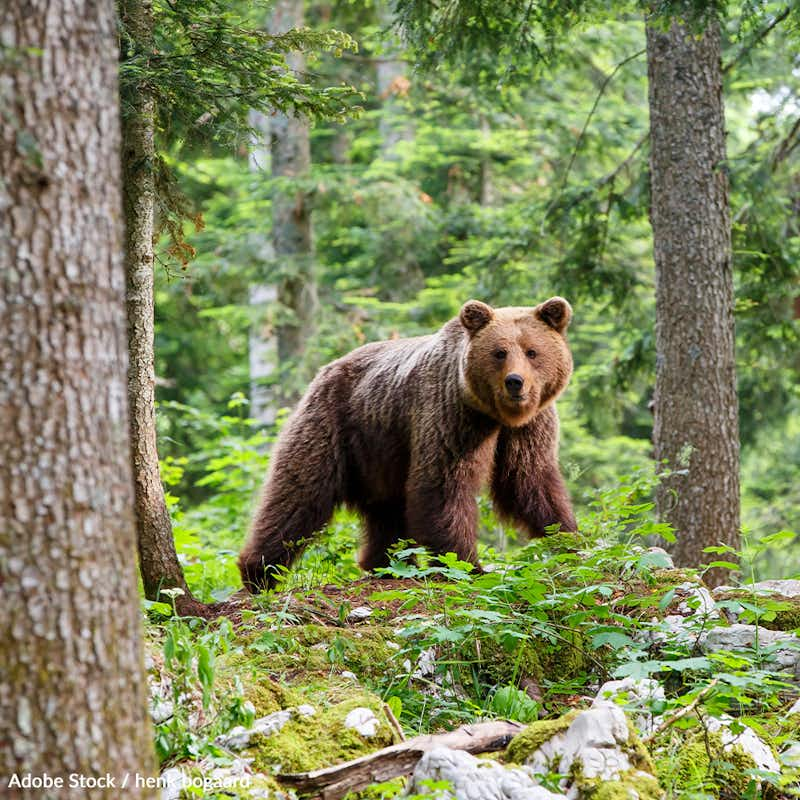Take Action for Wildlife Safety
3,817 signatures toward our 30,000 Goal
Sponsor: The Animal Rescue Site
Spring is a time for renewal, but it's also a time when wildlife emerges from hibernation. Pledge to keep yourself and wildlife safe this spring!

Spring is a time of renewal, and for wildlife in the United States, it's a time to emerge from their winter slumber. As the weather warms up and the snow melts away, animals begin to stir and come out of hibernation. While it's exciting to see these creatures out and about, human encounters can pose risks for both the wildlife and people, leading to:
- Injuries and fatalities: Wild animals can be dangerous, and human encounters can lead to injuries or even death1.
- Disruption of natural behavior: Human presence can disrupt animals' natural behavior, leading to changes in feeding patterns, mating habits, and migration routes2.
- Stress and anxiety: Human encounters can cause stress and anxiety in animals, leading to health problems and decreased survival rates3.
- Disease transmission: Contact with wildlife can lead to the transmission of diseases, including rabies, Lyme disease, and hantavirus4.
Humans should always remember to respect these creatures and give them space. To avoid conflicts, never approach or attempt to feed any wildlife and always be aware of your surroundings. As well:
- Stay calm and quiet: Sudden movements or loud noises can startle animals and cause them to flee or attack5.
- Keep your distance: Wildlife is unpredictable and can be dangerous, so it's essential to give them plenty of space. Yellowstone Park recommends staying at least 100 yards away from bears and wolves, and at least 25 yards away from all other animals6.
- Observe from a safe distance: Use binoculars or a camera to get a closer look without disturbing the animals7.
- Respect their space: If you encounter a nest, den, or burrow, keep a safe distance and don't disturb it8.
- Never feed wildlife: Feeding animals can disrupt their natural behavior and lead to aggression, health problems, and dependency on humans9.
- Keep your pets on a leash: Unleashed dogs can chase, harass, or attack wildlife, causing injury or death to both animals10.
- Follow park rules and regulations: National and state parks have specific guidelines for interacting with wildlife, so it's essential to read and follow these rules to ensure safety for both visitors and wildlife.
Spring is an exciting time to see wildlife emerge from their winter dens and burrows, but it's essential to respect these creatures and their habitats. Human encounters with wildlife can pose risks for both animals and people, so it's important to follow guidelines and respect their space. By doing so, we can ensure that these animals remain safe and healthy and continue to thrive in their natural environment.
Take the wildlife safety pledge and share this information with people you know!
- Center for Wildlife Information (2012), "All Wild Animals Can Be Dangerous."
- Tim S. Doherty, Graeme C. Hays, Don A. Driscoll, Nature Ecology & Evolution volume (01 February 2021), "Human disturbance causes widespread disruption of animal movement."
- Lynn B. Martin, Elizabeth Andreassi, William Watson, Courtney A. C. Coon, Nature Education (2011), "Stress and Animal Health: Physiological Mechanisms and Ecological Consequences."
- Kendra Stauffer, Ryan M. Wallace, G. Gale Galland, Nina Marano, National Center for Emerging and Zoonotic Infectious Diseases, Centers for Disease Control and Prevention (24 June 2019), "Animal Bites & Stings (Zoonotic Exposures)."
- Renee L. Rosier, Tracy Langkilde, Nature Education (2011), "Behavior Under Risk: How Animals Avoid Becoming Dinner."
- Courtney Holden, Yellowstone National Park Trip (3 May 2022), "How close can I get to wild animals in Yellowstone?."
- Jeremy Dertien, Courtney Larson, Sarah Reed, The Conversation (14 July 2021), "Don’t hike so close to me: How the presence of humans can disturb wildlife up to half a mile away."
- Kansas Department of Wildlife & Parks, "Wildlife Viewing Tips."
- James Hataway, UGA Today (10 March 2020, "Feeding wildlife can disrupt animal social structures."
- Navin Singh Khadka, BBC (12 February 2019), "Dogs' becoming major threat' to wildlife."
The Pledge:
As we enter the spring season, we are not the only ones emerging from our homes after a long winter. Wildlife animals, such as bears, coyotes, and deer, are also coming out of hibernation or seeking new territories, which means the likelihood of human-wildlife interactions increases. Unfortunately, these interactions can sometimes lead to injury or even death for both humans and animals. It is our responsibility to take action to reduce these incidents and ensure the safety of both ourselves and wildlife.
I pledge to take the following actions to reduce the incidents of injury or death from human-wildlife interactions this spring:
- Educate myself on the types of wildlife in my area, their behaviors, and how to safely coexist with them.
- Securely store trash and other potential food sources to discourage wildlife from coming onto my property.
- Use non-lethal methods to deter wildlife from entering my yard or garden, such as motion-activated sprinklers or lights.
- Keep a safe distance from wildlife and never approach or feed them.
- Keep my pets on a leash or indoors to prevent them from harassing or being attacked by wildlife.
- Drive cautiously in areas where wildlife may be present, especially at dawn and dusk when they are most active.
- Donate to or volunteer for organizations that promote wildlife conservation and coexistence, like Greater Good Charities, which has partnered with on-the-ground organizations in Florida to feed starving manatees, and with Project Peril to support programs that save bats, sea turtles and other species around the world.
- Advocate for policies and laws that protect wildlife habitats and prevent unnecessary harm to animals.
- Share my knowledge and encourage others on social media and in person to also take action to promote coexistence with wildlife.
- Respect the inherent value of all wildlife and their right to exist without undue harm or interference from humans.
By taking these actions, I pledge to do my part in reducing the incidents of injury or death from human-wildlife interactions in the spring and throughout the year.
Pledged by,
 Welcome Back! Log In to Continue
Welcome Back! Log In to Continue